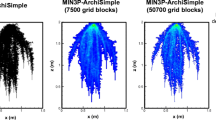Summary
This work develops the mathematical models suggested by various authors to simulate nutrient uptake of plants from soil. The simulation is based on ion transport from the soil to the roots by mass flow and diffusion and on Michaelis-Menten kinetics of nutrient uptake from soil solution by plant roots. For this purpose a differential equation is numerically integrated. Inter-root competition is allowed for by the choice of the boundary conditions. The integration procedure used makes it possible to take into account a variable buffer power which depends on soil solution concentration.
The model calculates the change of nutrient concentrations in soil as a function of distance from the root surface for preestablished periods of time. Furthermore, the rate of uptake and the quantity of nutrients taken up per cm of root length is obtained. If the growth function of the root is known, nutrient uptake of a growing root system can be calculated.
In order to verify the model two experiments were made:
-
1.
Potassium distribution was measured in a soil in the vicinity of rape roots under three different K levels. The calculated values agreed with the measured data.
-
2.
Potassium uptake of maize plants was measured in pot experiments with three different soils at two K levels each. Calculated K uptake agreed satisfactorily with measured K uptake.
It is therefore concluded that the theoretical conception of the model is realistic and that the parameters have correctly been measured. The model thus appears to be useful to simulate such aspects of nutrient uptake of plants from soil which cannot be measured.
Zusammenfassung
Die Arbeit hat das Ziel, die von verschiedenen Autoren vorgeschlagenen Rechenmodelle zur Beschreibung der Nährstoffaufnahme aus dem Boden zu entwickeln. Sie basieren auf dem Nährstofftransport vom Boden zur Wurzel durch Massenfluss und Diffusion sowie auf der Kinetik der Nährstoffaufnahme von Wurzeln aus der Bodenlösung nach der Michaelis-Menten-Kinetik. Dabei wird eine Differentialgleichung numerisch integriert. Die Konkurrenz der Wurzeln um Mineralstoffe wird durch die Wahl der Randbedingungen berücksichtigt. Das gewählte Integrationsverfahren ermöglicht die Einbeziehung einer variablen, von der Konzentration der Bodenlösung abhängigen Pufferung.
Das Modell errechnet die Änderung der Konzentration von Mineralstoffen im Boden mit zunehmender Entfernung von der Wurzeloberfläche in beliebigen Zeitspannen. Weiterhin wird die Aufnahmerate und die Nährstoffaufnahme pro cm Wurzel ermittelt. Its die Wachstumsfunktion der Wurzeln bekannt, so kann auch die Nährstoffaufnahme eines wachsenden Wurzelsystems errechnet werden.
Zur Verifizierung des Modells wurden zwei Versuche durchgeführt:
-
1.
Ein Boden wurde auf drei K-Gehalte gebracht und die Verteilung der K-Konzentration in der Umgebung von Rapswurzeln gemessen. Die Modellrechnung ergab eine gute Übereinstimmung zwischen der gemessenen und der errechneten Konzentrationsverteilung im wurzelnahen Boden.
-
2.
In einem Gefässversuch mit drei Böden und je zwei K-Stufen wurde die K-Aufnahme von Maispflanzen gemessen. Auch hier stimmete die gemessene K-Aufnahme mit dem Ergebnis der Modellrechnung befriedigend überein
Hieraus wird der Schluss gezogen, dass die theoretischen Vorstellungen, die dem Modell zugrundeliegen, realistisch sind und die verwendeten Parameter richtig gemessen wurden. Das Rechenmodell erscheint daher geeignet, um auch solche Aspekte der Mineralstoffaufnahme aus dem Boden zu untersuchen, die man nicht messen kann.
Similar content being viewed by others
References
Adams F 1974 Soil Solution.In The Plant Root and its Environment. Ed. E W Carson University Press of Virginia, Charlottesville.
Barber S A 1962 A diffusion and mass flow concept of soil nutrient availability. Soil Sci. 93, 39–49.
Barber S A 1984 Soil Nutrient Bioavailability, a Mechanistic Approach. John Wiley and Sons Inc., New York.
Barber S A and Cushman J H 1981 Nitrogen uptake model for agronomic crops. p. 382–409.In Modeling waste water renovation-land treatment. Ed J K Iskandar. J. Wiley-Interscience, New York.
Claassen N and Barber S A 1976 Simulation model for nutrient uptake from soil by a growing plant root system. Agron. J. 68, 961–964.
Cushman J H 1979 An analytical solution to solute transport near root surfaces for low initial concentration. I. Equation development. Soil Sci. Soc. Am. J. 43, 1087–1090.
Cushman J H 1984 Nutrient Transport inside and outside the root rhizosphere: Generalized Model. Soil Sci. 138, 164–179.
Epstein E 1972 Mineral nutrition of plants: Principles and Perspectives. John Wiley and Sons Inc., New York.
Kuchenbuch R and Jungk A 1982 A method for determining concentration profiles at the soil-root interface by thin slicing rhizospheric soil. Plant and Soil 8, 391–394.
Kuchenbuch R and Jungk A 1984 Wirkung der Kaliumdüngung auf die Kaliumverfügbarkeit in der Rhizosphäre von Raps. Z. Pflanzenernaehr. Bodenk 147, 435–448.
Kuchenbuch R, Claassen N and Jungk A Potassium availability in relation to soil moisture. II. Calculations by means of a mathematical simulation model. Plant and Soil 95, 233–243.
Nielsen N E 1976 A transport kinetic concept for ion uptake by plants. III. Test of the concept by results from water culture and pot experiments. Plant and Soil 45, 659–677.
Newman E J 1966 A method of estimating the total root length in a sample. J. Appl. Ecol. 3, 139–145.
Nye P H and Marriott H C 1969 A theoretical study of the distribution of substances around roots resulting from simultaneous diffusion and mass flow. Plant and Soil 30, 459–472.
Nye P H and Tinker P B 1977 Solute movement in the soil-root system. Blackwell Scientific Publishers, Oxford, England.
Remson I, Hornberger G M and Molz F J 1971 Numerical Methods in Subsurface Hydrology. John Wiley and Sons Inc., New York.
Williams R F 1948 The effect of phosphorus supply on the rates of intake of phosphorus and nitrogen upon certain aspects of phosphorus metabolism in gramineous plants. Aust. J. Sci. Res. (B), 1, 333–361.
Author information
Authors and Affiliations
Rights and permissions
About this article
Cite this article
Claassen, N., Syring, K.M. & Jungk, A. Verification of a mathematical model by simulating potassium uptake from soil. Plant Soil 95, 209–220 (1986). https://doi.org/10.1007/BF02375073
Received:
Revised:
Issue Date:
DOI: https://doi.org/10.1007/BF02375073




